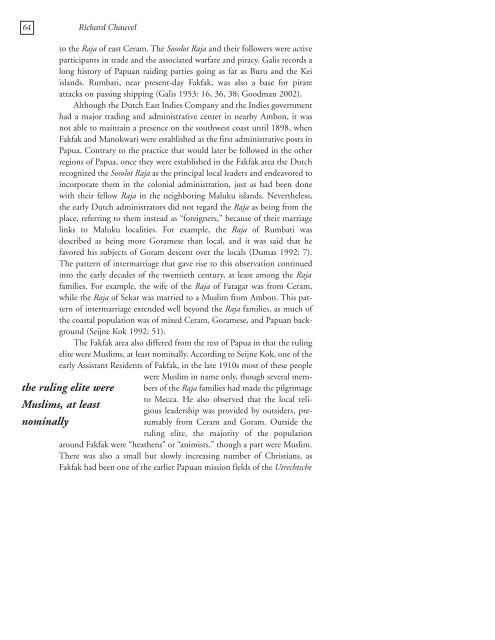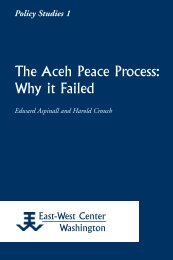Constructing Papuan Nationalism: History, Ethnicity ... - ScholarSpace
Constructing Papuan Nationalism: History, Ethnicity ... - ScholarSpace
Constructing Papuan Nationalism: History, Ethnicity ... - ScholarSpace
- No tags were found...
You also want an ePaper? Increase the reach of your titles
YUMPU automatically turns print PDFs into web optimized ePapers that Google loves.
64 Richard Chauvelto the Raja of east Ceram. The Sosolot Raja and their followers were activeparticipants in trade and the associated warfare and piracy. Galis records along history of <strong>Papuan</strong> raiding parties going as far as Buru and the Keiislands. Rumbati, near present-day Fakfak, was also a base for pirateattacks on passing shipping (Galis 1953: 16, 36, 38; Goodman 2002).Although the Dutch East Indies Company and the Indies governmenthad a major trading and administrative center in nearby Ambon, it wasnot able to maintain a presence on the southwest coast until 1898, whenFakfak and Manokwari were established as the first administrative posts inPapua. Contrary to the practice that would later be followed in the otherregions of Papua, once they were established in the Fakfak area the Dutchrecognized the Sosolot Raja as the principal local leaders and endeavored toincorporate them in the colonial administration, just as had been donewith their fellow Raja in the neighboring Maluku islands. Nevertheless,the early Dutch administrators did not regard the Raja as being from theplace, referring to them instead as “foreigners,” because of their marriagelinks to Maluku localities. For example, the Raja of Rumbati wasdescribed as being more Goramese than local, and it was said that hefavored his subjects of Goram descent over the locals (Dumas 1992: 7).The pattern of intermarriage that gave rise to this observation continuedinto the early decades of the twentieth century, at least among the Rajafamilies. For example, the wife of the Raja of Fatagar was from Ceram,while the Raja of Sekar was married to a Muslim from Ambon. This patternof intermarriage extended well beyond the Raja families, as much ofthe coastal population was of mixed Ceram, Goramese, and <strong>Papuan</strong> background(Seijne Kok 1992: 51).The Fakfak area also differed from the rest of Papua in that the rulingelite were Muslims, at least nominally. According to Seijne Kok, one of theearly Assistant Residents of Fakfak, in the late 1910s most of these peoplewere Muslim in name only, though several membersof the Raja families had made the pilgrimageto Mecca. He also observed that the local religiousleadership was provided by outsiders, presumablyfrom Ceram and Goram. Outside theruling elite, the majority of the populationaround Fakfak were “heathens” or “animists,” though a part were Muslim.There was also a small but slowly increasing number of Christians, asFakfak had been one of the earlier <strong>Papuan</strong> mission fields of the Utrechtschethe ruling elite wereMuslims, at leastnominally
















